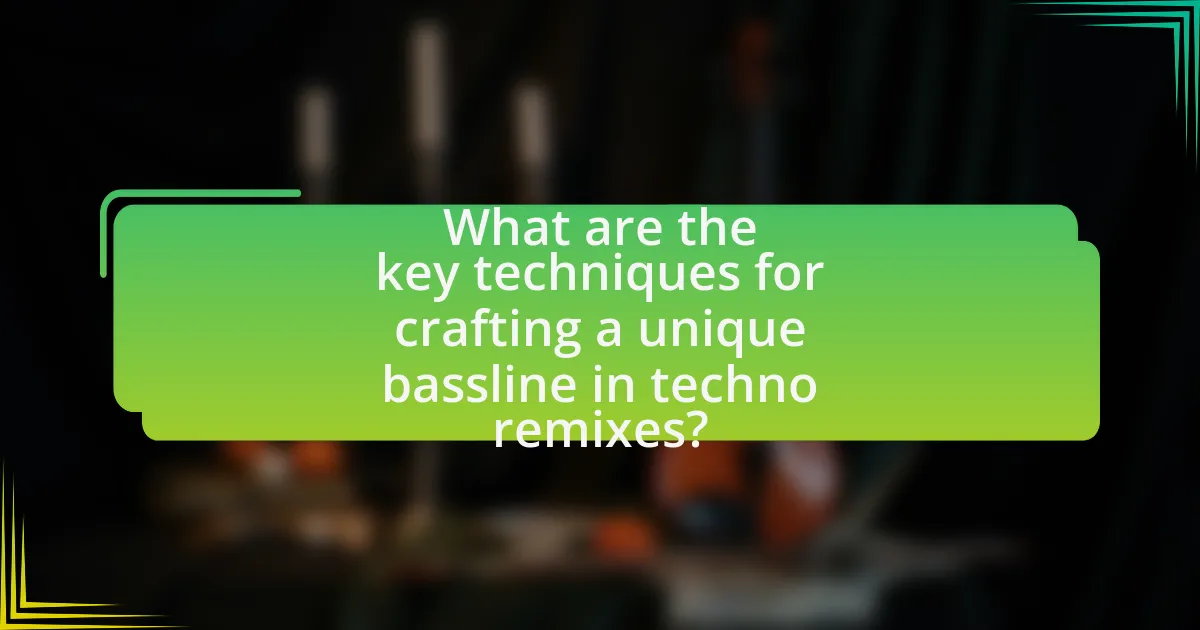The article focuses on techniques for crafting a unique bassline in techno remixes, emphasizing the importance of syncopation, layering, and modulation effects. It explores how a bassline influences the overall sound and groove of a track, highlighting the relationship between rhythm and bassline design. Additionally, the article discusses sound selection, synthesis, and the role of sampling in creating distinctive basslines, along with best practices for mixing and finalizing basslines to enhance their presence in a mix. Key strategies for innovation, troubleshooting common issues, and ensuring clarity in basslines are also covered, providing a comprehensive guide for producers in the techno genre.

What are the key techniques for crafting a unique bassline in techno remixes?
Key techniques for crafting a unique bassline in techno remixes include utilizing syncopation, layering different sounds, and applying modulation effects. Syncopation creates rhythmic interest by placing notes off the main beats, which enhances groove. Layering involves combining various bass sounds, such as sub-bass and mid-bass, to create a fuller and more dynamic texture. Modulation effects, like filter sweeps and pitch modulation, add movement and variation to the bassline, making it more engaging. These techniques are widely recognized in electronic music production, as they contribute to the distinctiveness and energy of techno tracks.
How does a bassline influence the overall sound of a techno remix?
A bassline significantly influences the overall sound of a techno remix by providing rhythmic foundation and harmonic depth. The bassline establishes the groove, which is essential in techno music, as it drives the energy and keeps the listener engaged. Additionally, a well-crafted bassline can enhance the emotional impact of the track, creating tension and release that complements the other elements, such as synths and percussion. For instance, a deep, rolling bassline can create a hypnotic effect, while a punchy, staccato bassline can add urgency and excitement. This relationship between the bassline and other components is crucial, as it shapes the overall texture and dynamics of the remix, ultimately defining its character and appeal.
What role does rhythm play in shaping a bassline?
Rhythm is fundamental in shaping a bassline as it establishes the groove and pulse of a track. The rhythmic pattern of a bassline interacts with the kick drum and other percussive elements, creating a cohesive foundation that drives the music forward. For instance, in techno, a syncopated bassline can enhance the energy and movement of a track, making it more engaging for listeners on the dance floor. Studies in music theory indicate that rhythmic variation in basslines can significantly influence listener perception and emotional response, reinforcing the importance of rhythm in bassline construction.
How can bassline variations enhance a remix?
Bassline variations can enhance a remix by introducing rhythmic diversity and emotional depth, which keeps the listener engaged. By altering the bassline’s rhythm, pitch, or texture, a remixer can create a fresh interpretation of the original track, making it more dynamic and appealing. For instance, a study by the University of California found that variations in bass frequencies can significantly affect listener perception and emotional response, indicating that well-crafted bassline changes can elevate the overall impact of a remix.
What elements contribute to a distinctive bassline in techno music?
A distinctive bassline in techno music is primarily characterized by its rhythmic consistency, deep sub-bass frequencies, and minimalistic melodic structure. The rhythmic consistency is achieved through repetitive patterns that create a driving force, often utilizing syncopation to add complexity. Deep sub-bass frequencies, typically produced using synthesizers or samples, provide the foundational low-end that is essential for the genre’s sound. Additionally, the minimalistic melodic structure often features simple, looping motifs that enhance the hypnotic quality of techno tracks. These elements collectively contribute to the unique identity of techno basslines, making them integral to the genre’s overall aesthetic.
How do sound selection and synthesis affect bassline uniqueness?
Sound selection and synthesis significantly influence bassline uniqueness by determining the tonal characteristics and texture of the sound. Unique basslines often arise from the careful choice of synthesizers, waveforms, and modulation techniques, which can create distinct sonic identities. For instance, using a subtractive synthesizer with a sawtooth waveform can yield a rich, harmonically complex bass sound, while FM synthesis can produce more metallic and evolving tones. Additionally, incorporating effects like distortion or filtering can further differentiate a bassline, making it stand out in a mix. The combination of these elements allows producers to craft basslines that are not only unique but also tailored to fit the specific vibe of a techno remix.
What effects can be applied to create depth in a bassline?
To create depth in a bassline, effects such as reverb, delay, and modulation can be applied. Reverb adds spatial characteristics, making the bassline feel more expansive and immersive. Delay can create rhythmic complexity and enhance the perception of depth by layering sounds. Modulation effects, like chorus or flanger, introduce movement and richness, further enriching the bassline’s texture. These effects are commonly used in music production to enhance the auditory experience, particularly in genres like techno, where depth and atmosphere are crucial for engaging listeners.
Why is layering important in bassline creation?
Layering is important in bassline creation because it enhances the depth and richness of the sound. By combining multiple bass sounds, producers can create a fuller and more complex audio texture that stands out in a mix. This technique allows for the blending of different frequencies and timbres, which can lead to a more engaging listening experience. For instance, layering a sub-bass with a mid-range bass can provide both the foundational low-end support and the melodic presence needed in techno tracks. This approach is supported by the fact that many successful techno tracks utilize layered basslines to achieve a dynamic and immersive sound, making it a crucial technique for producers aiming to craft unique basslines.
What types of sounds can be layered for a richer bassline?
To create a richer bassline, sounds such as sub-bass, kick drums, and synth bass can be effectively layered. Sub-bass provides depth and low-end frequency support, while kick drums add punch and rhythm. Synth bass can introduce harmonic complexity and texture, enhancing the overall sound. Layering these elements allows for a fuller and more dynamic bassline, which is essential in genres like techno where low frequencies play a crucial role in driving the track.
How does layering impact the mix of a techno track?
Layering significantly enhances the mix of a techno track by creating depth and richness in sound. This technique allows producers to combine multiple audio elements, such as basslines, synths, and percussion, which results in a fuller and more immersive listening experience. For instance, layering different bass sounds can add harmonic complexity and texture, making the low end more engaging. Additionally, using varied sound sources can help to fill the frequency spectrum, preventing any one element from dominating the mix. This approach is supported by the fact that well-layered tracks often achieve a more professional sound, as evidenced by the production techniques used by successful techno artists who prioritize intricate layering to maintain listener interest and drive energy on the dance floor.
How can one transition from basic to advanced bassline techniques?
To transition from basic to advanced bassline techniques, one should focus on incorporating complex rhythms, varied note lengths, and syncopation into their basslines. Advanced techniques include using techniques such as ghost notes, slides, and harmonics, which add depth and texture. Additionally, studying music theory, particularly scales and modes, enhances the ability to create more intricate basslines. Engaging with software tools like MIDI programming and audio effects can further refine the sound. Research indicates that musicians who practice these advanced techniques often achieve a more professional sound, as evidenced by the success of artists in the techno genre who utilize these methods in their remixes.
What are common pitfalls to avoid when crafting a bassline?
Common pitfalls to avoid when crafting a bassline include overcomplicating the rhythm, neglecting the relationship with other elements, and failing to maintain a consistent groove. Overcomplicating the rhythm can lead to a bassline that clashes with the track’s overall feel, making it difficult for listeners to connect with the music. Neglecting the relationship with other elements, such as drums and synths, can result in a bassline that feels isolated and disrupts the track’s cohesion. Maintaining a consistent groove is essential, as a disjointed bassline can detract from the danceability of techno music, which relies heavily on rhythmic consistency to engage the audience.

What specific strategies can enhance bassline creativity in techno remixes?
To enhance bassline creativity in techno remixes, producers can employ techniques such as layering different bass sounds, utilizing modulation effects, and experimenting with unconventional rhythms. Layering allows for a richer texture by combining various bass samples or synthesizer patches, which can create a more dynamic sound. Modulation effects, such as LFOs or envelopes, can introduce movement and variation, making the bassline more engaging. Additionally, experimenting with unconventional rhythms, such as syncopation or polyrhythms, can lead to unique grooves that stand out in a remix. These strategies are supported by the practice of many successful techno artists who prioritize innovation in their bassline design.
How can tempo and groove influence bassline design?
Tempo and groove significantly influence bassline design by dictating rhythmic patterns and the overall feel of the track. A faster tempo typically encourages more syncopated and energetic basslines, while a slower tempo allows for more sustained notes and a deeper groove. For instance, in techno music, a tempo around 125-130 BPM often leads to driving basslines that complement the percussive elements, creating a hypnotic effect. Conversely, at lower tempos, such as 110 BPM, basslines can become more melodic and spacious, enhancing the atmospheric quality of the track. This relationship between tempo and groove is essential for achieving the desired emotional impact and danceability in techno remixes.
What techniques can be used to syncopate a bassline effectively?
To effectively syncopate a bassline, musicians can employ techniques such as off-beat accents, rhythmic displacement, and the use of rests. Off-beat accents involve emphasizing notes that fall between the main beats, creating a sense of groove and unpredictability. Rhythmic displacement shifts the bassline’s pattern slightly forward or backward in the measure, which can create tension and interest. The use of rests strategically placed within the bassline can also enhance syncopation by creating gaps that draw attention to the notes that follow. These techniques are widely recognized in music theory and practice, as they contribute to the dynamic and engaging nature of basslines in genres like techno.
How does the choice of key affect bassline creativity?
The choice of key significantly influences bassline creativity by determining the harmonic framework within which the bassline operates. Different keys evoke distinct emotional responses and can inspire varied rhythmic and melodic ideas, leading to unique bassline compositions. For instance, a bassline in a minor key often conveys a darker, more introspective feel, while a major key typically produces a brighter, more uplifting sound. This emotional context can guide the creative process, as composers may gravitate towards specific patterns or motifs that resonate with the chosen key. Additionally, the intervals and relationships between notes in different keys can inspire innovative bassline structures, enhancing overall creativity in techno remixes.
What role does sampling play in creating unique basslines?
Sampling plays a crucial role in creating unique basslines by allowing producers to incorporate diverse sounds and textures from existing recordings. This technique enables the manipulation of audio clips, which can be altered in pitch, tempo, and effects, resulting in distinctive bass sounds that stand out in a mix. For instance, the use of samples from funk, jazz, or other genres can introduce rhythmic complexity and harmonic richness, enhancing the overall sonic palette of a techno remix. Additionally, sampling can evoke nostalgia or cultural references, making the bassline more engaging for listeners.
How can one effectively manipulate samples for bassline creation?
To effectively manipulate samples for bassline creation, one should utilize techniques such as pitch shifting, time stretching, and layering. Pitch shifting allows the bassline to fit within the desired key of the track, while time stretching can adjust the sample’s length without altering its pitch, enabling synchronization with the tempo. Layering different samples can create a richer sound by combining various textures and frequencies, enhancing the overall bassline presence. These methods are widely used in electronic music production, as they provide flexibility and creativity in sound design, allowing producers to craft unique basslines that stand out in techno remixes.
What are the best practices for integrating samples into a remix?
The best practices for integrating samples into a remix include ensuring that the samples complement the original track’s elements, maintaining a cohesive sound, and creatively manipulating the samples to add uniqueness. First, selecting samples that match the key and tempo of the original track is crucial for harmony. Additionally, using techniques such as time-stretching, pitch-shifting, and filtering can help blend samples seamlessly into the remix. According to a study by the University of California, Los Angeles, effective sample integration enhances listener engagement and can lead to a more dynamic remix. Furthermore, respecting copyright laws by obtaining necessary permissions for sample use is essential to avoid legal issues.
How can one utilize MIDI programming for bassline innovation?
One can utilize MIDI programming for bassline innovation by creating complex patterns and variations that enhance rhythmic and melodic elements. MIDI allows for precise control over note timing, velocity, and pitch, enabling the composer to experiment with syncopation, swing, and polyrhythms, which are essential in techno music. For instance, by programming different MIDI notes to trigger various synth sounds, one can layer basslines that evolve over time, adding depth and interest. Additionally, using MIDI effects such as arpeggiators or step sequencers can generate unique bassline sequences that would be difficult to compose manually, thus fostering creativity and innovation in bassline design.
What are the advantages of using MIDI over audio for basslines?
Using MIDI for basslines offers several advantages over audio, primarily flexibility and ease of editing. MIDI allows for precise control over pitch, timing, and velocity, enabling musicians to easily modify notes, change instruments, or adjust dynamics without the need for re-recording. This adaptability is crucial in the production of techno remixes, where basslines often require rapid iterations and experimentation. Additionally, MIDI files are smaller in size compared to audio files, facilitating quicker loading times and more efficient storage. These characteristics make MIDI an essential tool for producers aiming to craft unique and dynamic basslines in their tracks.
How can automation enhance the expressiveness of a bassline?
Automation can enhance the expressiveness of a bassline by allowing dynamic changes in parameters such as volume, filter cutoff, and effects over time. This capability enables producers to create variations that mimic human performance nuances, making the bassline more engaging and emotive. For instance, automating the filter cutoff can introduce movement and tension, while volume automation can emphasize certain notes or phrases, contributing to the overall groove. Studies in music production show that tracks with automated elements often achieve higher listener engagement, as they provide a sense of evolution and complexity that static basslines lack.

What are the best practices for finalizing a bassline in a techno remix?
The best practices for finalizing a bassline in a techno remix include ensuring tight synchronization with the kick drum, using sidechain compression for a pumping effect, and maintaining a consistent groove. Tight synchronization with the kick drum enhances the rhythmic foundation, making the bassline feel more cohesive within the track. Sidechain compression allows the bassline to breathe and creates a dynamic interplay with the kick, which is essential in techno music. Maintaining a consistent groove ensures that the bassline complements the overall rhythm and energy of the track, keeping listeners engaged. These practices are supported by the common techniques used in successful techno productions, where the bassline is a critical element for driving the track forward.
How can mixing techniques improve the presence of a bassline?
Mixing techniques can significantly enhance the presence of a bassline by optimizing its frequency range, dynamics, and spatial placement within a track. Techniques such as equalization (EQ) allow for the removal of conflicting frequencies, ensuring the bassline occupies its own sonic space, which is crucial in genres like techno where low-end clarity is essential. Compression can be applied to control the dynamics of the bassline, making it more consistent and impactful, thus increasing its perceived loudness without overwhelming other elements. Additionally, using techniques like sidechain compression can create a rhythmic pumping effect that accentuates the bassline’s presence in relation to the kick drum, further solidifying its role in the mix. These methods collectively ensure that the bassline is not only audible but also feels powerful and integral to the overall sound, which is vital for engaging listeners in techno music.
What EQ strategies are effective for bassline clarity?
Effective EQ strategies for bassline clarity include cutting unnecessary low frequencies, boosting around 60-80 Hz for warmth, and applying a high-pass filter to remove sub-bass muddiness. Cutting frequencies below 30 Hz can prevent distortion and allow for a cleaner mix. Boosting in the 200-300 Hz range can enhance presence, while careful attenuation around 400-500 Hz can reduce boxiness. These strategies help ensure that the bassline remains distinct and well-defined within the overall mix, contributing to a more polished sound in techno remixes.
How can compression be used to tighten a bassline sound?
Compression can be used to tighten a bassline sound by reducing the dynamic range, which helps to create a more consistent and punchy low-end presence. By applying compression, the louder peaks of the bassline are attenuated while the quieter parts are amplified, resulting in a more uniform sound that sits well in the mix. This technique is particularly effective in electronic music genres like techno, where a tight bassline is essential for driving the rhythm. Studies have shown that properly compressed basslines can enhance the perceived loudness and clarity, making them more impactful in a track.
What tips can help in troubleshooting common bassline issues?
To troubleshoot common bassline issues, start by checking the sound levels and ensuring the bassline is not overpowering other elements in the mix. Properly balancing the bass with kick drums and other instruments is crucial, as an unbalanced mix can lead to muddiness. Additionally, use EQ to carve out space for the bassline, typically by reducing frequencies that clash with other instruments, particularly in the low-mid range around 200-400 Hz. Compression can also help maintain a consistent level and sustain of the bassline, preventing it from sounding too dynamic or inconsistent. Finally, consider the arrangement; ensuring the bassline complements the overall rhythm and melody can resolve issues related to musicality and coherence.
How can one identify and fix muddiness in a bassline?
To identify and fix muddiness in a bassline, one should analyze the frequency spectrum using an equalizer to pinpoint overlapping frequencies that cause clutter. Muddiness often occurs in the 200-400 Hz range, where bass instruments can mask each other. By applying a high-pass filter to remove unnecessary low frequencies and using subtractive EQ to reduce problematic frequencies, clarity can be restored. Additionally, ensuring proper arrangement and spacing in the mix can help separate the bassline from other elements, enhancing overall definition. This approach is supported by audio engineering principles that emphasize frequency management for clearer mixes.
What steps can be taken to ensure a bassline sits well in the mix?
To ensure a bassline sits well in the mix, one should focus on proper EQing, balancing levels, and utilizing sidechain compression. EQing allows for the removal of conflicting frequencies, particularly in the low-mid range, which can muddy the mix. Balancing levels ensures that the bassline is neither overpowering nor too quiet compared to other elements, maintaining clarity. Sidechain compression creates space by ducking the bassline in response to the kick drum, enhancing the rhythmic feel and allowing both elements to coexist without clashing. These techniques are widely used in professional mixing to achieve a cohesive sound.


